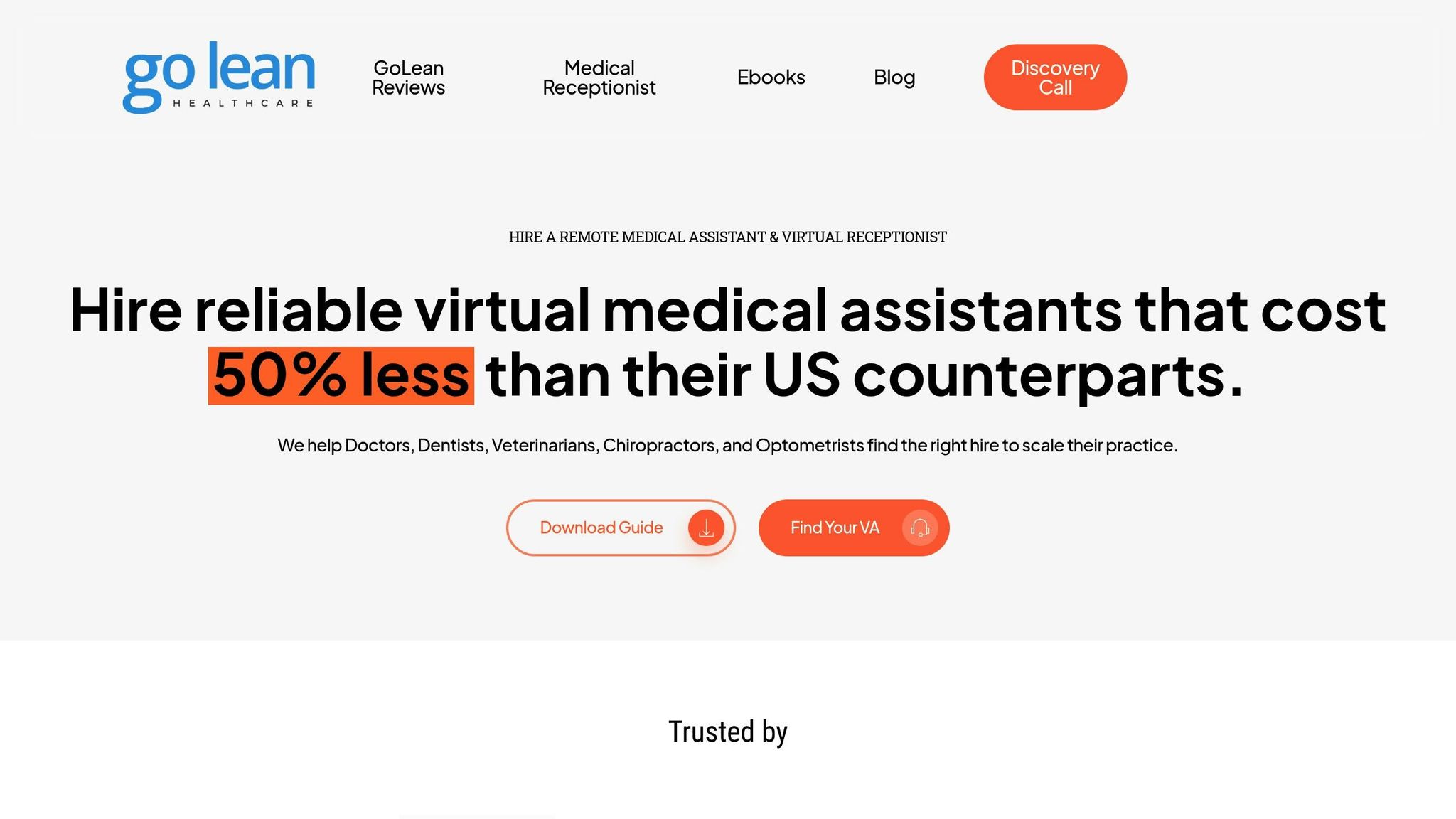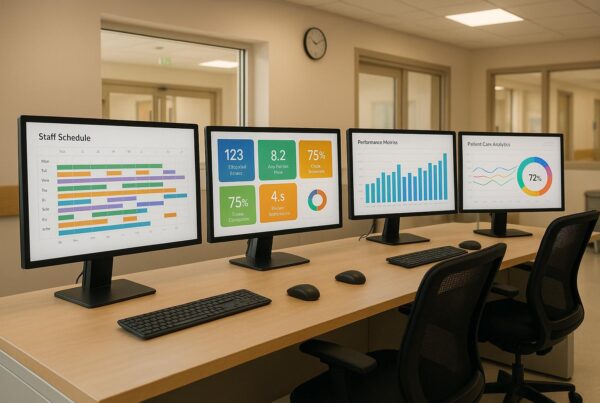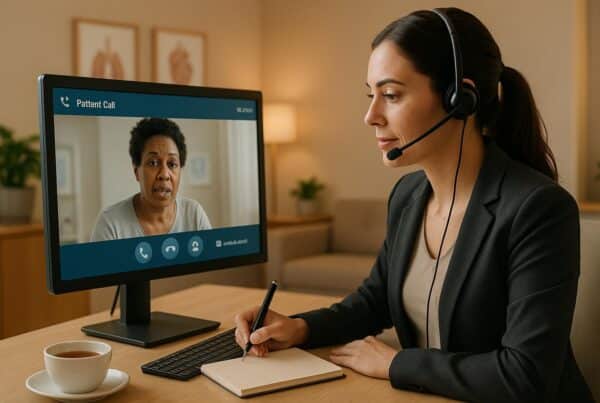Virtual assistants are transforming healthcare administration by tackling time-consuming tasks like scheduling, insurance verification, billing, and managing electronic medical records (EMR). These tools reduce errors, speed up processes, and lower costs – helping practices focus on patient care instead of paperwork.
Key takeaways:
- Cost Savings: Practices save up to 70% on staffing expenses by using virtual assistants.
- Efficiency Gains: Tasks like insurance verification become faster and more accurate, cutting down errors and delays.
- Improved Patient Experience: Reduced no-show rates (by 22%) and better communication lead to higher patient satisfaction.
- HIPAA Compliance: Virtual assistants follow strict data security protocols, ensuring patient information is protected.
For healthcare providers struggling with administrative bottlenecks, virtual assistants offer a practical way to streamline operations, improve financial performance, and deliver better patient care.
Webinar | How To Integrate Virtual Assistants Into Your Healthcare Practice
What Virtual Assistants Do in Healthcare Administration
Virtual medical assistants play a crucial role in handling administrative tasks that often weigh down healthcare practices. They take on responsibilities like patient scheduling, billing, insurance verification, and managing Electronic Medical Records (EMR). With specialized training in healthcare administration and HIPAA compliance, they help practices run more efficiently while safeguarding patient information [2][5]. Considering that 42% of doctors report burnout [6] and U.S. physicians spend an average of 8.7 hours per week on administrative work [3], virtual assistants provide much-needed support, allowing in-house staff to focus more on patient care.
"Virtual medical assistants streamline administrative tasks, allowing your front desk staff to focus on patient-facing responsibilities." – Wow Remote Teams [4]
Their expertise lays the groundwork for smoother scheduling, billing, and record management, as detailed below.
Scheduling and Patient Coordination
Virtual assistants enhance scheduling processes by managing appointment bookings, cancellations, rescheduling requests, and waitlists, ensuring providers’ schedules stay on track [7]. They also implement appointment reminder systems using phone calls, text messages, and emails, which can significantly reduce no-show rates. Since no-shows cost practices an average of $200 per unused time slot [7], these efforts can lead to substantial savings.
Additionally, virtual assistants optimize scheduling by aligning appointment types with appropriate time slots, grouping similar procedures, and accommodating provider preferences [7]. Beyond just managing schedules, they ensure patients receive clear communication about their care plans, treatment options, and appointment details. They address concerns promptly, creating a more seamless and reassuring experience for patients throughout their healthcare journey [9].
For example, a case study featuring ClearDesk‘s remote scheduler, Roanne, collaborating with a Home Instead franchise, demonstrated how streamlined scheduling could lead to 100% of shifts being scheduled in advance and a 40% improvement in accuracy and timeliness [8].
Billing, Claims Processing, and Insurance Verification
Medical billing and insurance tasks are often complex and prone to errors. Virtual assistants help simplify these processes by automating repetitive tasks like patient data entry, insurance verification, and claims processing. This not only reduces errors but also speeds up claim approvals [10].
They verify patient insurance coverage in real time, ensuring that details are accurate and up-to-date before services are rendered [10][12]. This proactive approach minimizes claim rejections and billing delays.
"Medical Virtual Assistants can streamline medical practices by efficiently handling insurance verifications, ensuring timely reimbursements and reducing administrative burdens on in-house staff." – Global Medical VA [5]
Virtual assistants also manage billing tasks such as tracking deductibles and copays [11]. They explain coverage details to patients and secure necessary referrals [11]. By verifying financial responsibilities upfront, they help prevent denied reimbursements and rejected claims [13].
The financial benefits of outsourcing these tasks are compelling. Healthcare providers can save up to 70% on staffing costs by using virtual assistants [10]. Many practices also report faster processing times, fewer errors, and reduced costs within just a few months of implementation [10]. Alongside billing, virtual assistants streamline document management within EMR systems.
EMR Management and Documentation
Managing Electronic Medical Records is another area where virtual assistants excel. They handle data entry, update patient records, and maintain accurate documentation – essential tasks for compliance and quality patient care. With specialized HIPAA training, they ensure patient information remains secure [2].
Virtual assistants are skilled in working with various EMR systems, adapting to a practice’s existing technology infrastructure. By efficiently managing documentation workflows, they help prevent bottlenecks that can disrupt operations. Automating data entry and cross-checking claims for compliance also improves medical billing accuracy and reduces human error [10].
How Virtual Assistants Reduce Admin Bottlenecks
Bringing virtual assistants into your healthcare practice isn’t just about hiring – it’s about thoughtful planning and seamless integration. This involves taking a hard look at your current administrative struggles, setting up clear workflows, and maintaining consistent performance standards to get the most out of your investment without disrupting daily operations.
Assessing Administrative Needs
Before diving in, it’s crucial to pinpoint where virtual assistants can make the biggest difference. Start by evaluating your administrative processes to identify bottlenecks. Are you grappling with financial management, patient retention, or even staff burnout? Look at recurring issues like overloaded schedules, training gaps, or limited office space. Common time-draining tasks – such as appointment scheduling, insurance verification, billing follow-ups, and EMR data entry – are prime candidates for delegation to virtual assistants.
Virtual assistants are trained to handle these tasks efficiently, offering the added benefit of working flexible hours and scaling up quickly as your practice grows. Once you’ve identified your needs, it’s easier to design an onboarding process that integrates them smoothly into your operations.
Onboarding and Workflow Setup
A well-structured onboarding plan is essential for setting virtual assistants up for success. Start with a simple pre-boarding process: send a welcome email with login credentials and an overview of the tools they’ll need. On their first day, arrange a quick video call to introduce them to the team, share your practice’s mission, and assign them a mentor. This mentor can guide them through key tasks, like handling intake calls or managing billing.
To ensure consistency, create clear Standard Operating Procedures (SOPs) and task checklists for duties like appointment scheduling, sending reminders, and verifying insurance. Use engaging HIPAA training tools, such as animated videos and quizzes, to keep compliance front and center. Offer hands-on training for EMR systems in a test environment so they can practice without risking live data.
A 30-60-90 day roadmap with specific goals can help track their progress. Meanwhile, small rituals like morning huddles or virtual coffee breaks can foster team connection. Companies like GoLean simplify this process by providing HIPAA-trained assistants who are already proficient in EMR systems. For instance, Dr. James Mitchell’s family practice in Savannah, Georgia, reduced administrative costs by 60% and saw a 40% boost in patient satisfaction – all within the first month [14].
Monitoring and Improving Performance
To ensure your virtual assistants deliver consistent value, keep an eye on key metrics. Track things like appointment scheduling accuracy, billing turnaround times, insurance verification success rates, and response times for patient communications. Establish measurable goals, review performance regularly, and provide constructive feedback to celebrate wins and address areas for improvement.
Success stories underscore the impact of virtual assistants. Dr. Carolynn Francavilla, Founder and CEO of Green Mountain Partners for Health, highlighted how virtual assistants transformed her practice:
"One of the most high-value things we have gotten out of our virtual assistants is to train them on how to complete these prior authorizations to really help our patients get the medications they need." [1]
This targeted training not only improved patient access to medications but freed up in-person staff to focus more on direct patient care. Virtual assistants can also send timely appointment reminders and follow-ups, reducing missed appointments – a massive cost-saving measure, considering missed appointments cost the U.S. healthcare system around $150 billion annually [15]. Personalized medication reminders can further boost treatment adherence by up to 25%, improving overall patient outcomes.
Regular feedback ensures your virtual assistants stay aligned with your practice’s evolving needs, delivering consistent value over time.
sbb-itb-109dad4
Benefits of Virtual Assistants: Measurable Results
The impact of virtual assistants in healthcare is more than just theoretical – real-world data highlights their ability to transform practices. Clinics across the U.S. report marked improvements in efficiency, cost savings, and patient satisfaction, addressing some of the most persistent administrative challenges.
Improved Efficiency and Cost Savings
Virtual assistants deliver noticeable financial advantages. Practices can cut staffing expenses by as much as 70% – a significant reduction compared to hiring in-house staff. On-site assistants typically cost between $40,000 and $70,000 annually (including benefits and overhead), while virtual assistants range from $12,000 to $25,000 per year[18][19].
The financial benefits don’t stop at staffing. Revenue cycles become more streamlined, with clinics seeing billing collections speed up by around 30%. One clinic even reported a 50% increase in claim approval rates after using a virtual medical assistant for coding and billing follow-ups[18]. Faster payment cycles mean better cash flow, allowing practices to allocate resources toward patient care instead of chasing overdue payments.
Operational efficiency also gets a boost. For example, a multi-specialty clinic reduced its operational costs by 60% after integrating virtual assistants into its workflows[17]. The growing adoption of these tools is reflected in market projections, with the global healthcare virtual assistant market expected to hit $2.1 billion by 2031[16]. Even smaller practices reap the rewards – one clinic saved as much as $50,000 annually by switching to virtual medical assistants[23]. These cost and efficiency gains not only lighten the administrative load but also enhance the overall patient experience.
Enhanced Patient Satisfaction
Virtual assistants don’t just help behind the scenes – they also improve patient satisfaction. When administrative tasks like appointment management are handled more effectively, patients notice. Clinics report about a 15% boost in patient satisfaction rates[18]. Additionally, no-show rates drop by roughly 22%, ensuring patients receive timely care while practices maintain steadier revenue streams[22][23].
Better communication plays a key role in these improvements. Over 70% of patients are comfortable using voice or chat assistants for scheduling, reminders, and basic inquiries[20]. By taking over routine calls, virtual assistants free up human staff to focus on more complex needs, with some clinics reporting a 40% reduction in routine call volume. Digital tools also make a difference – one practice saw a 47% increase in bookings through its virtual assistant interface, while another reported a similar 47% rise in follow-up appointments scheduled via automated reminders[20][21]. These changes lead to higher satisfaction scores and stronger patient loyalty.
Before and After: A Clear Picture
The benefits of virtual assistants are evident when comparing key performance metrics before and after their implementation:
| Metric | Before Virtual Assistants | After Virtual Assistants | Improvement |
|---|---|---|---|
| No-Show Rate | High appointment no-shows | 22% fewer missed appointments | Protected revenue |
| Billing Collections | Slower payment cycles | Faster processing times | Better cash flow |
| Claim Approval Rate | Lower approval rates | Up to 50% increase | Higher revenue capture |
| Patient Satisfaction | Standard satisfaction levels | Improved ratings | Greater patient loyalty |
| Call Center Volume | High routine call traffic | 40% fewer routine calls | More efficient staff allocation |
| Digital Bookings | Limited online scheduling | 47% increase in digital appointments | Modernized patient engagement |
| Staffing Costs | Full in-house team expenses | Up to 70% savings | Significant cost reduction |
| Operational Costs | Standard overhead | Up to 60% reduction | Enhanced profitability |
These metrics clearly show how virtual assistants go beyond easing administrative tasks – they transform operations, reduce costs, and elevate the patient experience.
Compliance and Security with Remote Support
Incorporating virtual assistants into healthcare operations isn’t just about improving efficiency – it also requires meeting strict compliance and security standards to protect patient data. Given the sensitive nature of patient health information (PHI), healthcare providers must prioritize rigorous safeguards. Failure to comply with these standards can result in serious legal and financial consequences.
In the first half of 2024 alone, healthcare providers reported over 387 data breaches, with human error being one of the leading causes[25]. This highlights the necessity of choosing a virtual assistant provider that places a strong emphasis on data protection and adherence to regulatory requirements.
HIPAA and Data Security Standards
The Health Insurance Portability and Accountability Act (HIPAA) plays a crucial role in safeguarding patient data and maintaining trust[24]. Virtual assistants trained in HIPAA compliance follow strict protocols, including encrypted communication channels, secure data storage, and controlled access to PHI. These measures ensure that sensitive information remains protected.
Business Associate Agreements (BAAs) further solidify these efforts by clearly defining the responsibilities of virtual assistants in handling PHI. These agreements ensure accountability, even when staff operate remotely.
To maintain high security standards, providers implement regular audits and continuous monitoring, including role-based access controls. These practices not only protect data but also ensure that the operational benefits of virtual assistants don’t come at the expense of security.
Bilingual and Culturally Competent Support
For the diverse patient populations in the U.S., bilingual support is more than a convenience – it’s essential. For example, nearly one-third of Hispanic Americans prefer healthcare providers who speak Spanish[27]. Effective bilingual support can improve communication, reduce administrative delays, and even enhance compliance.
Patients with Limited English Proficiency (LEP) face significant barriers in healthcare. They are 50% more likely to experience serious medical events during hospital stays, over twice as likely to be readmitted within 30 days, and 30% may avoid seeking care altogether due to language barriers[26]. Additionally, appointments with LEP patients often take 25% longer, adding strain to healthcare practices[26].
Bilingual virtual assistants help address these challenges by ensuring patients fully understand their diagnoses, treatment plans, and discharge instructions. This improves medication adherence and follow-up care. For instance, one community health center saw notable improvements after implementing bilingual solutions: a 20% reduction in appointment wait times, a 15% increase in medication adherence among Spanish-speaking patients, and a 30% rise in overall patient satisfaction[26]. These outcomes demonstrate how bilingual support can positively impact both patient care and practice efficiency.
GoLean‘s Commitment to Compliance and Quality

GoLean tackles compliance and security challenges head-on with a comprehensive strategy that prioritizes patient safety and operational efficiency. Every GoLean assistant undergoes HIPAA training to ensure they meet the highest standards of data protection.
Leveraging a global talent pool, GoLean offers access to bilingual professionals – particularly Spanish-speaking assistants – who are well-prepared to support diverse patient populations. This is especially beneficial in areas with large Hispanic communities, where language barriers can affect both compliance and patient satisfaction.
GoLean also secures PHI through robust Business Associate Agreements, which clearly define the responsibilities of remote staff. Their expertise in electronic medical record (EMR) systems ensures that virtual assistants integrate seamlessly into existing workflows without compromising security.
To reinforce confidence in their services, GoLean offers a 30-day money-back guarantee. This allows healthcare practices to evaluate their solutions while maintaining trust in their compliance and security measures.
Conclusion: Improving Healthcare Administration with Virtual Assistants
Healthcare practices across the country are rethinking how they manage their administrative tasks, thanks to the growing use of virtual assistants. The numbers don’t lie – virtual assistants are helping to lighten the administrative load that has long been a challenge for the healthcare industry.
By taking over tasks like scheduling, insurance verification, billing, and electronic medical record (EMR) management, virtual assistants free up healthcare providers to do what they do best: care for patients. This shift directly tackles the daily stress caused by administrative overload, a common issue for many professionals in the field.
"You can remove a lot of administrative burden that may be very stressful to the physicians at the practice", says Dr. Carolynn Francavilla, Founder and CEO of Green Mountain Partners for Health [1].
Security and compliance are, of course, non-negotiable in healthcare. Virtual assistants trained in HIPAA protocols follow strict guidelines, use encrypted communication tools, and work under Business Associate Agreements to safeguard patient data. For practices serving diverse populations, bilingual assistants add an extra layer of accessibility, breaking down language barriers and improving communication.
Companies like GoLean are stepping up to meet these needs. Their HIPAA-trained virtual assistants specialize in EMR management, offer bilingual support, and maintain rigorous compliance standards. Plus, their 30-day money-back guarantee gives practices the confidence to explore these solutions without hesitation.
For practices dealing with administrative bottlenecks, virtual assistants are a game-changer. They help reduce costs, boost efficiency, and allow more time for patient care. The real question isn’t whether virtual assistants can make a difference – it’s how quickly practices can adopt these tools to start seeing results.
"The time savings have been incredible. Our staff is less stressed, and I can focus more on seeing patients", shares Dr. Joe [28].
FAQs
How do virtual assistants protect patient information and ensure HIPAA compliance?
Virtual assistants are designed to comply with strict HIPAA guidelines to ensure the protection of sensitive patient information. They rely on encrypted communication tools, secure messaging systems, and strong access controls to keep data safe. On top of that, they are trained to verify identities, secure necessary consents, and follow established privacy protocols.
To maintain compliance, these assistants regularly participate in HIPAA training. This keeps them up to date on the latest regulations, enabling them to handle tasks like scheduling, billing, and insurance verification with a high level of confidentiality and security.
How can virtual assistants help healthcare practices save money on administrative tasks?
Integrating virtual assistants into your healthcare practice can be a game-changer when it comes to cutting costs. By outsourcing tasks like scheduling, billing, and insurance verification, practices have reported reducing administrative expenses by up to 78%. To put this into perspective, many practices save over $16,000 annually on billing alone.
Beyond direct cost savings, virtual assistants help trim overhead expenses. There’s no need to worry about training, providing office space, or covering employee benefits. Plus, they offer a flexible, efficient solution that adapts to your practice’s specific needs. This frees up healthcare providers to spend more time focusing on patients and less time buried in administrative work.
How can virtual assistants enhance patient satisfaction and reduce appointment no-shows in healthcare?
Virtual assistants significantly enhance patient satisfaction by delivering personalized and timely communication while cutting down on wait times. They efficiently manage tasks like scheduling appointments and handling follow-ups, ensuring patients feel supported and appreciated.
To tackle no-show rates, virtual assistants send reminders through calls, texts, or emails, keeping patients informed about upcoming appointments. Rescheduling is made effortless, improving time management for both patients and healthcare providers. By simplifying these processes, virtual assistants create a smoother, more patient-centered experience.



